LisbonLisboaPortugal.com
The best independent guide to Lisbon
LisbonLisboaPortugal.com
The best independent guide to Lisbon
Lisbon in February: Is it a good month to visit?
February offers a glimpse of Lisbon as it was before mass tourism; a time when neighbourhood cafés belong to regulars, trams have empty seats, and you might be the only visitor climbing the ramparts of São Jorge Castle.
The backdrop for this authentic scene is the tail-end of winter. Though winter weather persists with frequent Atlantic showers and cool temperatures, there are the first hints of spring, with noticeably longer days and occasional afternoons warm enough to linger outside.
The rewards for braving February's unpredictability are substantial. This is your last chance for rock-bottom prices before rates begin climbing in March. More importantly, you'll experience Lisbon as residents know it. Restaurants treat you as guests rather than tourists, museum guards have time to share stories about their favourite pieces, and tram drivers might wait an extra moment as you hurry to catch their car.
Success in February requires embracing indoor Lisbon as enthusiastically as its outdoor attractions. This is the month to discover why locals spend hours in their neighbourhood tascas, to understand the ritual of the afternoon pastel de nata, and to explore museums you'd skip in better weather. When sunshine does break through, it feels like a gift, sending everyone onto terraces and viewpoints with the grateful enthusiasm of those who know not to take good weather for granted.
This guide will show you how to experience Lisbon like a local in February, balancing indoor pursuits with strategic outdoor adventures when the weather cooperates.
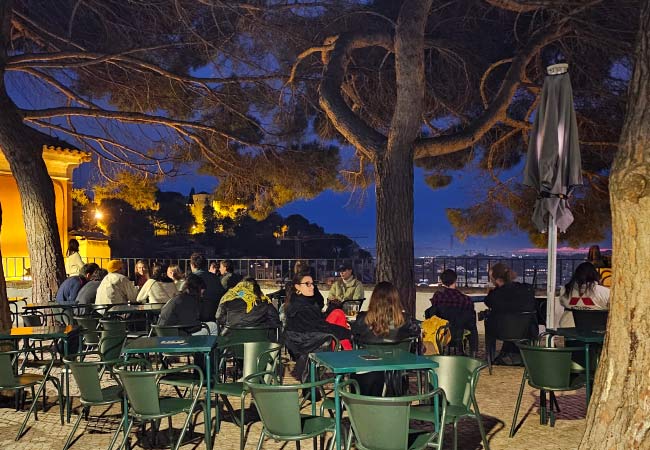
Wrapping up warm to watch the sun set (around 6pm) from the Miradouro da Graça
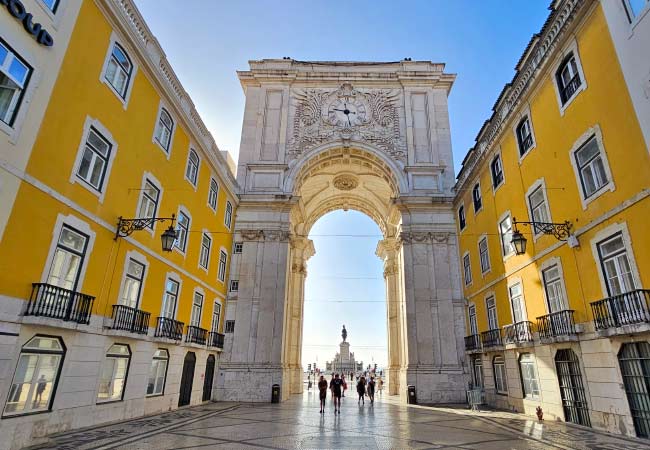
The Arco da rua Augusta - Lisbon will have significantly fewer tourists than in the peak summer months
Lisbon Weather in February
February in Lisbon continues the winter season, but often provides the first promising hints of the approaching spring.
On average, February has daytime highs of 16C (61F), which fall to a cool 9C (48F) at night. You can expect around 6 hours of sunshine per day, with rain on approximately 12 days of the month, contributing to 85mm of precipitation.
The defining characteristic of February's weather is its unpredictability. While it can be one of Lisbon's wetter months, the winter rains are often broken by extended periods of bright, clear skies. These sunny spells can feel surprisingly mild and spring-like, offering a welcome break from the winter gloom.
For visitors, the weather can feel like a lottery. A trip might coincide with a week of damp, grey weather, or with a period of glorious sunshine perfect for exploring. The days are noticeably lengthening after the peak of winter, but evenings are still chilly, and a warm, waterproof jacket remains essential.
Insight: February in Lisbon is often significantly milder and sunnier than in almost any other major European capital, making it an appealing destination for a late-winter escape.
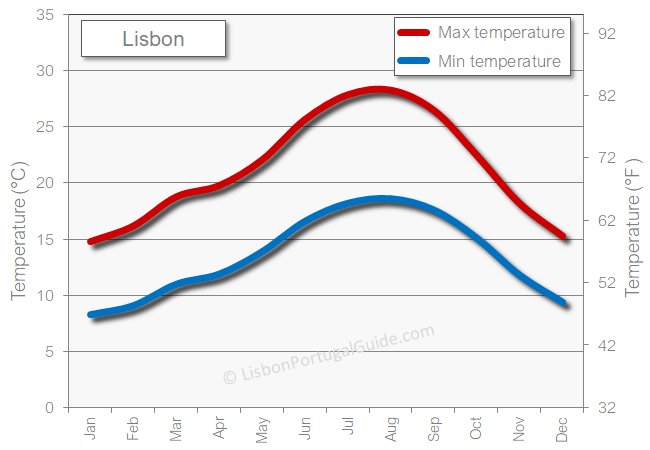
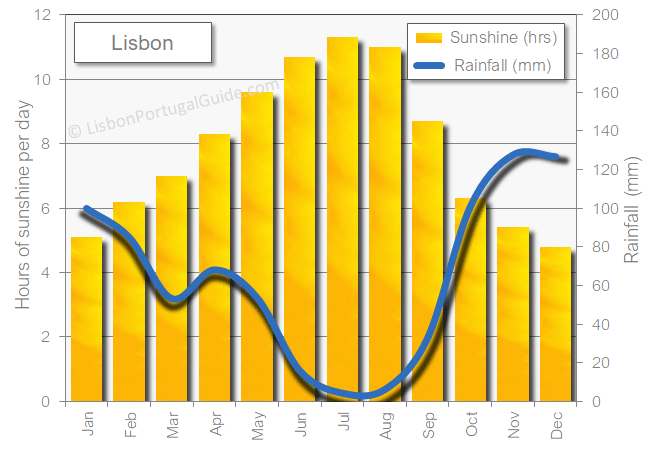
Highlights of Lisbon in February
February in Lisbon is the city's quietest month, with the first slight hints of spring but the very presence of heavy rain. Here are experiences that work particularly well this time of year:
• Alfama & São Jorge Castle: Climb through the historic labyrinth of Alfama’s streets to the city’s highest point, São Jorge Castle. After exploring the ancient Moorish fortress and its ramparts, descend back through the neighbourhood’s cobbled alleys to discover hidden courtyards and viewpoints.- Alfama guide
• Oceanário de Lisboa: A world-class aquarium renowned for its innovative design. The main attraction is an enormous five-million-litre central tank that creates the illusion of a single global ocean, home to sharks, rays, and massive sunfish.
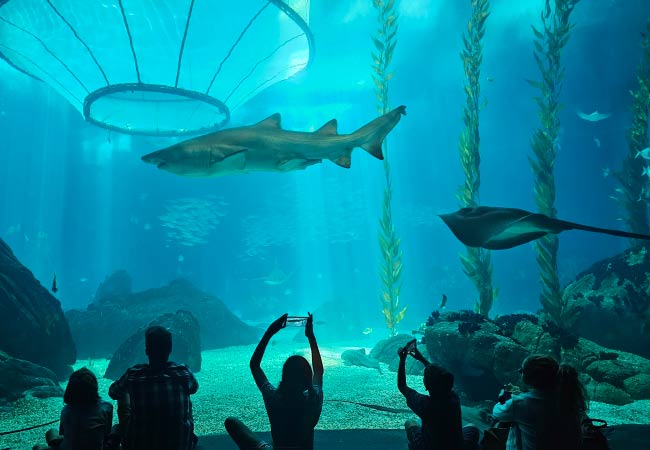
• Jerónimos Monastery: This UNESCO World Heritage site is the masterpiece of Manueline architecture, a symbol of Portugal's Age of Discovery. Its breathtaking two-story cloister is famed for its delicate, lace-like arches decorated with intricate maritime carvings - Jerónimos Monastery.
• Tram 28: Experience the famous Tram 28 route as the locals do. In the quiet of February, you can often find a seat on this historic tram, enjoying an unobstructed view as it rattles through the narrow streets of Alfama and Graça on its daily journey. - Tram 28 guide.
• LX Factory: A former 19th-century industrial complex transformed into a vibrant creative hub. Explore its independent boutiques and concept restaurants, and be sure to visit the monumental Ler Devagar bookstore, built within a former printing press.
• Fado Performance: The reflective atmosphere of a winter evening is the perfect backdrop for Fado. Seek out a small, traditional Fado house in Alfama or Bairro Alto for an authentic evening dedicated to the powerful vocals and melancholic guitars of Portugal's most famous musical tradition.- Fado guide.
• Museu Calouste Gulbenkian: This celebrated museum houses a remarkable private collection that spans 5,000 years of art. Journey from ancient Egyptian artefacts to masterpieces by Rembrandt, Monet, and René Lalique, all displayed in an award-winning modernist building.
• National Tile Museum: Housed in the stunning Madre de Deus Convent, this unique museum is dedicated to the art of the Portuguese azulejo tile. Trace the five-century history of this national art form, culminating in the magnificent panorama of pre-earthquake Lisbon.
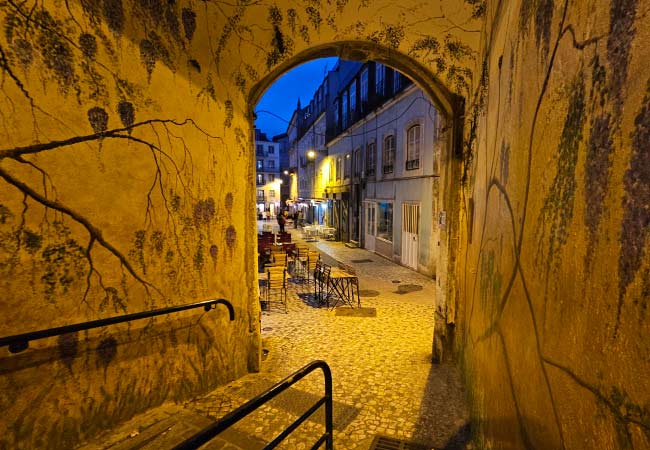
What to do in Lisbon when it rains in February
February's unpredictable weather calls for a flexible itinerary packed with engaging indoor options.
For a full day of entertainment sheltered from the elements, head to the modern Parque das Nações district. Here you can explore the magnificent Oceanário de Lisboa, one of Europe's finest aquariums, before visiting its neighbour, the Pavilhão do Conhecimento, a brilliant, hands-on science museum ideal for children . Also here is the Vasco da Gama shopping centre, offering options for food and retail therapy.
A wet day also provides the perfect, unhurried opportunity to explore Portugal's cultural treasures. While the Museu Calouste Gulbenkian offers a journey through 5,000 years of global art, the Museu Nacional do Azulejo gives a unique insight into the nation’s soul through its iconic tilework. For a truly spectacular display, the Museu Nacional dos Coches showcases the opulent history of royal transport in its collection of magnificent carriages.
You could also spend an afternoon at the LX Factory, a creative hub where former warehouses shelter independent design shops, art galleries, and unique restaurants. Another great option is joining a Portuguese cooking class, where you can learn the secrets behind local dishes or master the art of the perfect pastel de nata.
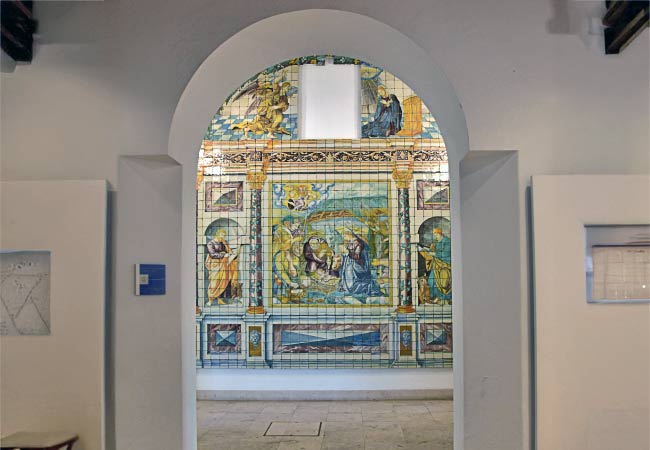
Have you booked your hotel yet?
February offers fantastic value for accommodation, but the best places still book up first. Enter your dates on the map below to see live prices and availability across the city.
Booking.comSintra in February
Even in the depths of winter, Sintra's allure as Lisbon's premier day trip remains strong. While the prospect of crowd-free palaces is tempting, a visit in February requires the same careful planning as the preceding months.
The town’s position in the Serra de Sintra mountains creates a challenging microclimate that is markedly cooler and wetter than the capital. Unpredictable mists can sweep in with little warning, concealing the hilltop palaces even if the day starts with promise in Lisbon.
A visit during heavy rain or mist means sacrificing the very things that make Sintra magical. The panoramic views disappear, Pena Palace’s colours become muted and dreary, and the ancient castle ramparts can turn treacherous. A poorly timed visit guarantees a day spent cold and damp, rather than enchanted.
Ultimately, a successful February visit is a gamble on the weather. Always check a dedicated forecast for the hills before setting out. The reward is a chance to see these wonders in peaceful solitude; the risk is a day spent underwhelmed and eager to return to Lisbon.
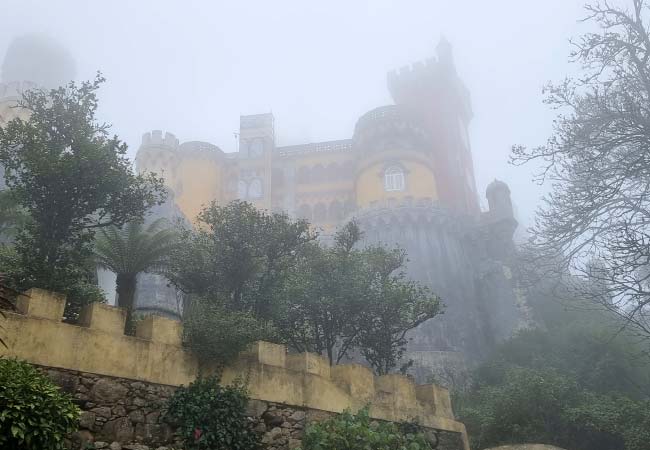
Sintra is often shrouded in fog, which can linger almost all of the day
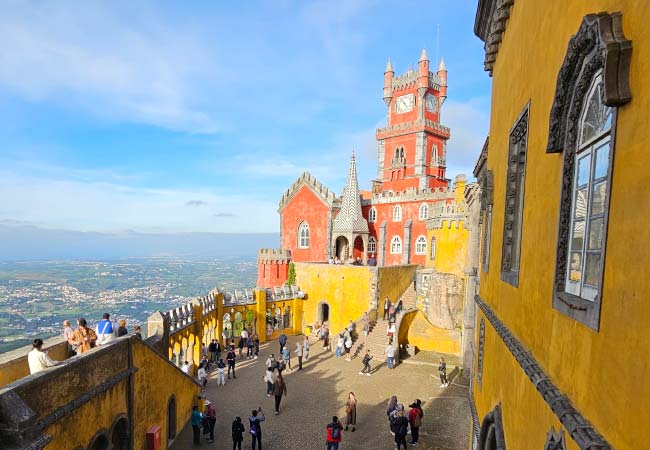
However, on a clear, sunny day, the Pena Palace will be at its quietest for the entire year.
A Suggested Itinerary for a February to Lisbon
A five-day visit to Lisbon offers an ideal timeframe to experience the city’s diverse neighbourhoods without the rush that a shorter trip demands. This itinerary is structured to provide a comprehensive and logical introduction to the city, balancing its historical monuments with its modern, creative energy.
Day 1: The Medieval Alleys of Alfama and Grandeur of Baixa
The first day is devoted to Lisbon's historic soul, contrasting the ancient, labyrinthine streets of Alfama with the planned elegance of the Baixa district. The soft light of February often brings a special quality to the city, enhancing the rich colours of the tiled facades and offering beautiful conditions for photography from the city’s many viewpoints.
The journey begins at Castelo de São Jorge, the city's historic citadel. Walking along its ancient fortified walls provides an unparalleled introduction to Lisbon, with 360-degree views across the sprawling cityscape and the broad Tagus River. From this high vantage point, you can trace the path down into Alfama, the city's oldest neighbourhood. Having largely survived the 1755 earthquake, its layout offers a glimpse into medieval Lisbon. Exploring its maze of steep, cobbled streets reveals hidden courtyards, traditional tascas, and the melancholic sound of Fado music drifting from open doorways.
Within Alfama, key landmarks offer cultural refuge. The Sé de Lisboa, an imposing Romanesque cathedral with a fortress-like exterior, stands as a monument to the city's resilience. The district is also famous for its miradouros (viewpoints), and a stop at the Miradouro das Portas do Sol offers the classic postcard view of Alfama's rooftops cascading towards the river.
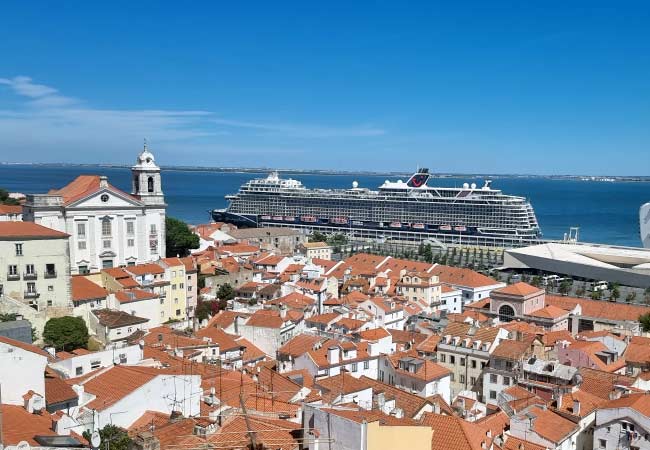
In the afternoon, the exploration shifts to the lower city and the Baixa district. A model of 18th-century urban planning, its ordered grid of streets and grand neoclassical architecture is the result of the ambitious rebuilding that followed the 1755 earthquake. The district’s main artery, the pedestrianised Rua Augusta, serves as its vibrant spine, lined with shops, outdoor cafés, and traditional tiled facades. This grid contains other important public spaces, including the bustling Rossio Square with its wave-patterned cobbles and bronze fountains, and the ornate, wrought-iron structure of the Elevador de Santa Justa, a unique piece of industrial-age engineering.
The streets of Baixa ultimately lead towards the Tagus River, culminating in one of Europe’s most impressive squares, the Praça do Comércio. Entry to this vast riverfront plaza is through the monumental Arco da Rua Augusta, a triumphal arch which can be ascended for elevated views of the district. The square itself, framed by uniform yellow, arcaded buildings, opens dramatically onto the water, historically serving as Lisbon's maritime and commercial gateway.
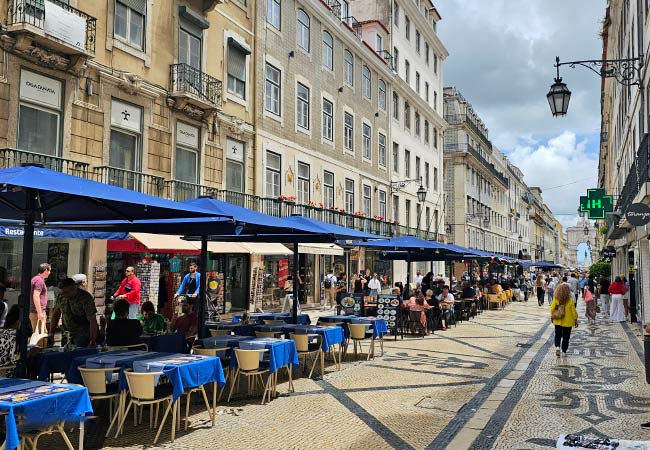
Day 2: Golden Age Monuments and Modern Creativity
This day explores Belém, the riverside district that serves as a powerful tribute to Portugal’s 15th and 16th-century Age of Discoveries. Here, monumental architecture celebrates a history of maritime exploration, while a visit to a nearby creative hub provides a vibrant look at the Lisbon of today.
The architectural jewel of Belém is the Mosteiro dos Jerónimos, a UNESCO World Heritage site. It is a masterpiece of Manueline design, a uniquely Portuguese form of late Gothic architecture rich with intricate stone carvings of maritime and royal symbols. Its ornate two-level cloisters are a highlight and can be appreciated fully in the quieter winter season. A short walk from the monastery is Pastéis de Belém, where you can taste the original pastel de nata, made from a secret recipe held by the bakery since 1837.
The riverfront is dominated by two other important landmarks. The Torre de Belém, an elegant fortified tower sitting at the water's edge, has become a symbol of Lisbon itself. Nearby, the dramatic, modern Padrão dos Descobrimentos (Monument to the Discoveries) celebrates the navigators, cartographers, and patrons who shaped Portugal’s golden age.
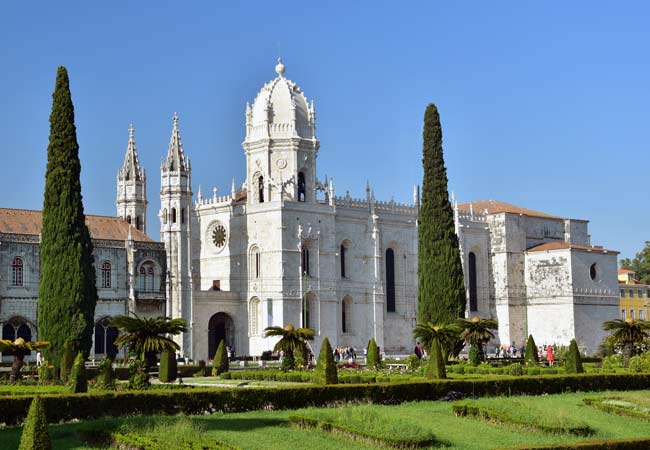
In the afternoon, a visit to LX Factory provides a vibrant counterpoint to the historic monuments of Belém. This former 19th-century factory complex in the Alcântara district has been reborn as the energetic centre of Lisbon’s creative scene. Within its industrial spaces, you can explore independent shops, artist studios, and innovative restaurants. As evening arrives, LX Factory becomes a prime destination for dinner and drinks, showcasing the modern, bohemian spirit of the city.
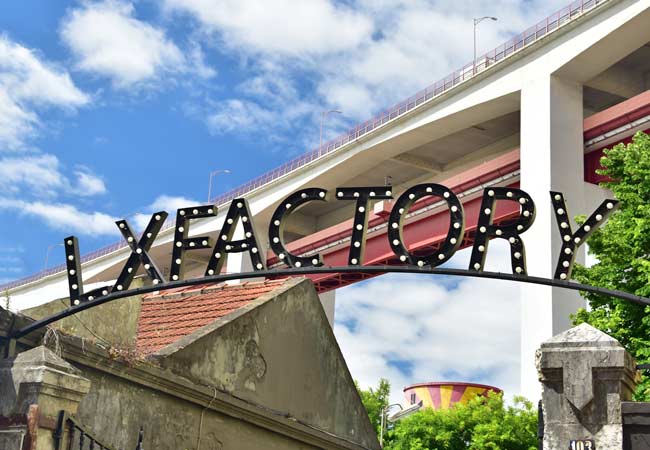
Day 3: The Elegant Heartlands of Chiado and Estrela
The final day focuses on Lisbon’s sophisticated cultural and commercial districts, from the literary cafés of Chiado to the tranquil parks of Estrela, offering a taste of both the city’s intellectual buzz and its refined residential life.
Begin in Chiado, Lisbon’s elegant cultural heart. It is a neighbourhood of grand theatres, historic cafés, and fashionable international shops. Here you can visit Livraria Bertrand, the world's oldest operating bookshop, or have a coffee at A Brasileira, long a favourite haunt of writers and artists. The ornate, wrought-iron Elevador de Santa Justa is both a local landmark and a functional lift, connecting Chiado to the Baixa and offering superb views from its upper platform.
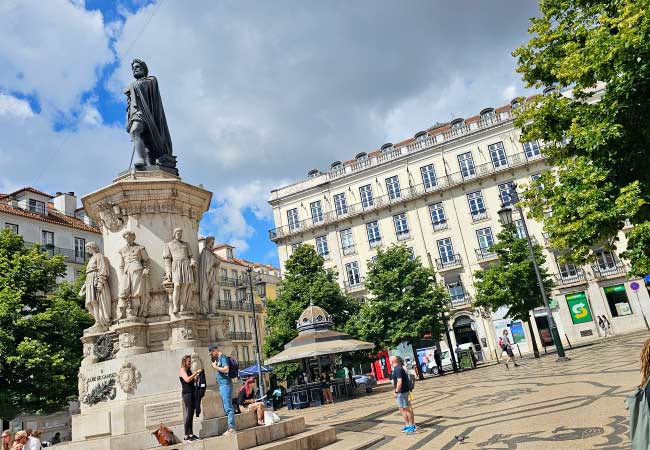
From Chiado, the streets lead uphill to the chic district of Príncipe Real, known for its concept stores, art galleries, and antique shops. This area sits next to the Bairro Alto, a grid of quiet residential streets by day that transforms into the city's liveliest nightlife district after dark. Linking the two is the Miradouro de São Pedro de Alcântara, a landscaped terrace with one of the city’s finest panoramic views, looking directly across to the Castelo de São Jorge.
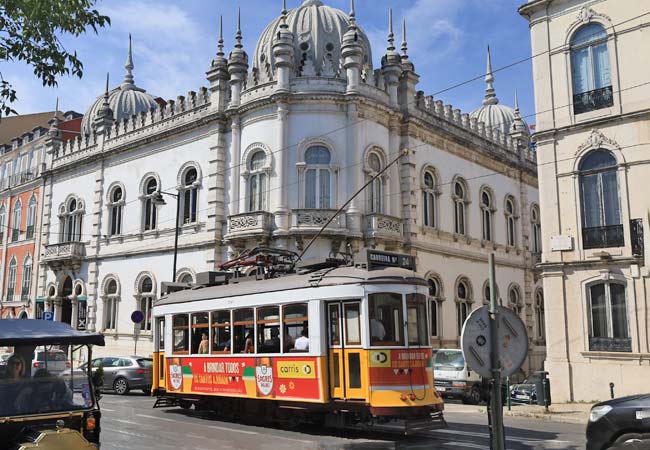
The number 24 tram passing through Príncipe Real
Day 4: The Fairytale Palaces of Sintra
A day trip to Sintra is an excursion into a realm of fantasy, a town of magnificent palaces and lush, mystical estates set within misty, forested hills. Easily reached by a short train ride from Lisbon’s Rossio Station, this UNESCO World Heritage landscape was the summer sanctuary for Portuguese royalty, who left behind an incredible architectural legacy.
Dominating the landscape from its perch atop the highest peak is the Palácio da Pena. A breathtaking example of 19th-century Romanticism, the palace is a vibrant collage of colours, with whimsical turrets, domes, and battlements creating an unforgettable silhouette against the sky. Its eclectic mix of architectural styles is matched by the lavish interiors, and its terraces offer panoramic views that, on a clear day, extend to the Atlantic coast.
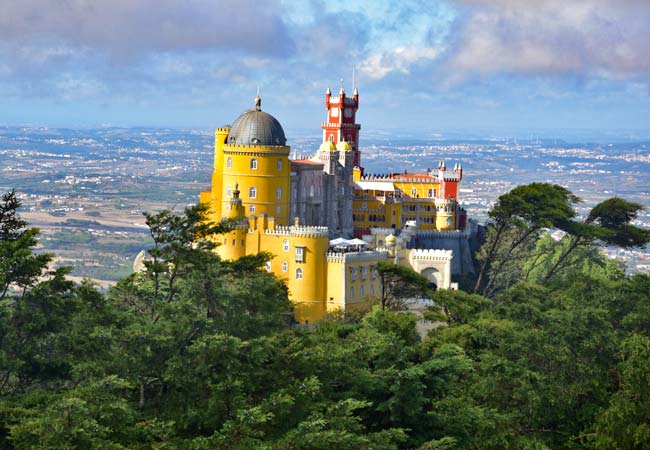
Equally compelling, though different in character, is the Quinta da Regaleira. This is an enigmatic property where the sprawling gardens are the main event, filled with allegorical statues, hidden grottoes, and a network of tunnels. Its most famous feature is the Initiation Well, a subterranean spiral staircase that plunges deep into the earth, creating an experience of mystery and discovery.
In the historic town centre below, the Palácio Nacional de Sintra is instantly recognisable by its two immense conical chimneys. As the best-preserved medieval royal residence in Portugal, its simpler exterior hides a rich history within its walls. Given the vastness of the estates and the hilly terrain, it is wise to select two or three main sites. This approach allows for a more immersive and unhurried experience of Sintra’s unique magic.
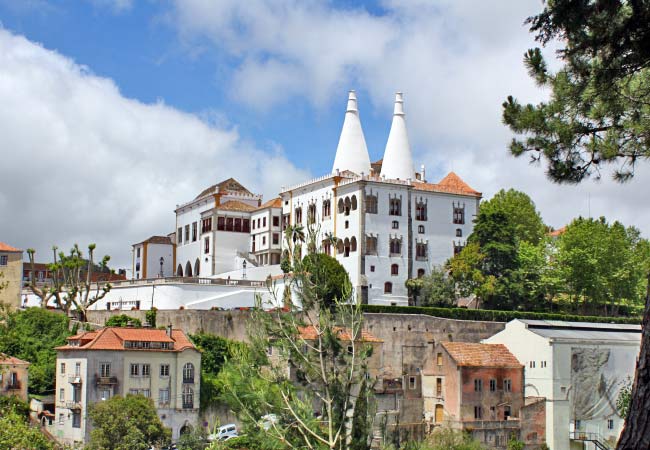
Day 5: Contemporary Lisbon
The final day is dedicated to Lisbon's forward-thinking identity, exploring two major urban regeneration projects that showcase different sides of the city's contemporary spirit. The day moves from the sleek, planned architecture of Parque das Nações to the repurposed industrial creativity of LX Factory.
The morning destination is Parque das Nações, the futuristic waterfront district built to host the 1998 World Expo. Its centerpiece is the Oceanário de Lisboa, widely considered one of Europe's finest aquariums. The institution is celebrated for its innovative design, featuring a massive central tank that represents the unified global ocean, surrounded by four stunning reconstructions of different marine ecosystems. The area is also an open-air display of bold modern architecture, exemplified by the striking, skeletal structure of the Oriente Station, designed by Santiago Calatrava. For aerial views of the district and the impressive Vasco da Gama Bridge, a ride on the cable car is highly recommended.
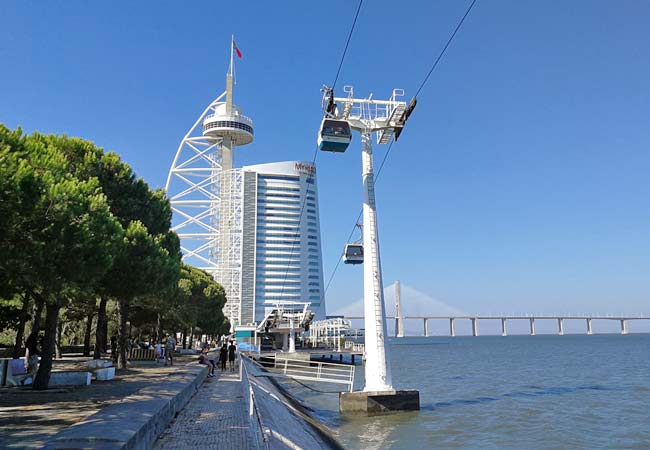
For a tranquil afternoon, the Estrela district offers a glimpse into refined local life. Its centerpiece is the magnificent, dome-topped Basílica da Estrela, whose ornate white marble and rococo interior is breathtaking. Directly opposite the basilica is the Jardim da Estrela, a beautifully landscaped park filled with exotic plants and dotted with kiosks. It is a favourite green space among locals and provides a peaceful setting to relax and observe daily life in the city.
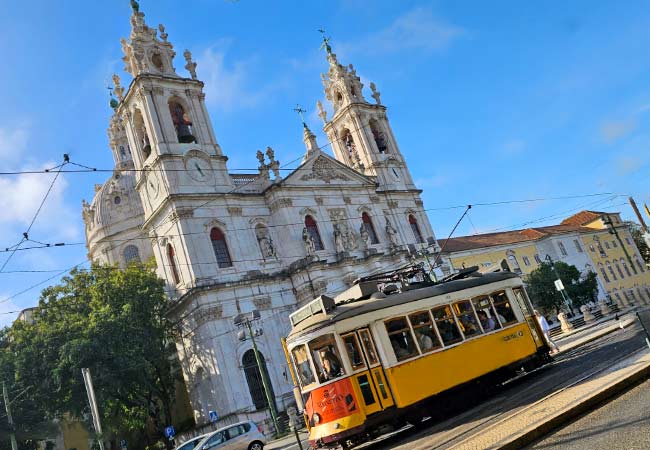
Discover more of Lisbon with our most popular guides
If you've found our content valuable, we'd welcome your support.
The digital publishing landscape has evolved significantly. As a small independent publisher, we face growing challenges. Search engines increasingly favour paid content over organic results, while AI-generated content often reproduces original work without attribution.
To support our work, please consider bookmarking this page (press Ctrl + D) for quick access. If you find an article helpful, we'd be grateful if you'd share it with friends on social media.
For specific questions, please see our Reddit community at r/LisbonPortugalTravel.
Should you notice any outdated or incorrect information, please contact us at [email protected]
Thank you for helping us continue to provide valuable content in an increasingly challenging digital environment.
A complete list of all of our Lisbon articles
If you've found our content valuable, we'd welcome your support.
The digital publishing landscape has evolved significantly. As a small independent publisher, we face growing challenges. Search engines increasingly favour paid content over organic results, while AI-generated content often reproduces original work without attribution.
To support our work, please consider bookmarking this page (press Ctrl + D) for quick access. If you find an article helpful, we'd be grateful if you'd share it with friends on social media.
For specific questions, please see our Reddit community at r/LisbonPortugalTravel.
Should you notice any outdated or incorrect information, please contact us at [email protected]
Thank you for helping us continue to provide valuable content in an increasingly challenging digital environment.



































